7 Aristotelian-Medieval Worldview
Chapter 7: Aristotelian-Medieval Worldview
Intro
So far, we’ve been studying some of the central philosophical questions about science: Can we know anything with absolute certainty? Is there a universal and unchangeable method of theory evaluation? What is the mechanism of scientific change? Is there scientific progress? What is the difference between science and pseudoscience? Now we are moving to the history of science, and we will focus on some examples of major scientific worldviews through history.
But why would anyone bother studying the scientific worldviews of the past? After all, from the perspective of contemporary science, most elements of past mosaics would be simply unacceptable. So, what’s the point of studying theories and methods that were rejected such a long time ago? There are at least two reasons to do this – one historical and one philosophical.
The historical reason for studying the worldviews of the past is that it helps us better understand the events of the past. It is appreciated nowadays that one cannot properly make sense of past events unless they are considered in their proper historical contexts. Any historical context includes not only a certain social organization, economic and political structure, but also – and importantly – a certain set of accepted beliefs about the world. We’ve already seen in chapter 4 that it is impossible to make sense of the case of Galileo without knowing the accepted theories and employed methods of the Aristotelian-Medieval mosaic of his time. This can be generalized: understanding a certain historical transition requires knowledge of the respective historical context, including the mosaic or mosaics of the time.
In addition, there is an important philosophical reason for studying worldviews of the past: it helps us improve our picture of science by better understanding the process of scientific change. Imagine what sort of picture of science would emerge if we were to ignore pre-eighteenth-century science. We do not need to guess. It was customary until the 1960s or even 1970s to dismiss the whole of pre-Newtonian/pre-Galilean science as not really belonging to the history of science: hundreds of years of Aristotelian-Medieval science were cast aside! As a result, most notable philosophers of that time ended up believing that there is one fixed and universal method of science. While we no longer accept the idea of a fixed and universal method of science, even nowadays some philosophers nonetheless still believe that there is one universal method of science. This is usually an unfortunate outcome of their decision to disregard the whole history of knowledge before the 17th century. If we dismiss the science of the past simply because it employed a different method of theory evaluation, then we have to be prepared for our science to be dismissed once our current methods, such as the HD method, gets replaced by some new method. A more sensible option is to acknowledge the importance of past mosaics and study them with utmost care.
A few important clarifications are in order before we proceed. Firstly, any worldview is a complex entity with thousands of different accepted theories and a wide range of methods for evaluating theories. Thus, a comprehensive exposition of a single worldview can take volumes. In our discussion, however, we focus on a small subset of accepted theories and employed methods to give a cursory snapshot of some of the key elements of a worldview.
Secondly, throughout history, there have been many distinct epistemic communities with distinct worldviews; of these, we only focus on four worldviews which constitute a historical sequence – Aristotelian-Medieval, Cartesian, Newtonian, and Contemporary. This selection accomplishes two goals: it gives a snapshot of some of the most influential scientific worldviews of all time, and it helps illustrate how theories, methods, and whole worldviews change through time.
Thirdly, scientific mosaics are not static entities. They constantly evolve; theories and even methods change all the time. Thus, no matter what year and what epistemic community we choose, we inevitably end up with a snapshot of that community’s mosaic at that particular time. There is much more to the history of science than these four worldviews.
Fourthly, our reconstructions of these four worldviews are done from a bird’s-eye perspective: they skip any mention of specific epistemic communities that bore these mosaics. While this is acceptable for an introductory textbook, a proper historical study should start from identifying the epistemic communities of the time under scrutiny and then proceed to extracting the content of their mosaics.
In this chapter we will consider the first of our four worldviews – the Aristotelian-Medieval mosaic. What were some of the key elements of the Aristotelian-Medieval mosaic? As with any other mosaic, the Aristotelian-Medieval mosaic included a vast array of different theories and methods. Among these are the Aristotelian natural philosophy (physics) of one celestial and four terrestrial elements, humoral physiology and medicine, the geocentric cosmology of concentric spherical shells, natural history (biology), and mathematics, as well as the Aristotelian-Medieval method of intuition schooled by experience. In addition to these elements, we also find a number of surprising inclusions such as astrology, the study of celestial influence upon terrestrial events, and theology, the study of God. Both astrology and theology were considered legitimate topics of scientific inquiry and their theories were part of the mosaic of the time. In fact, different medieval communities often accepted different theologies, such as those of Christianity (catholic, orthodox, protestant, etc.), Islam, or Judaism. In any event, a theology was virtually always an indispensable component of any Aristotelian-medieval mosaic.
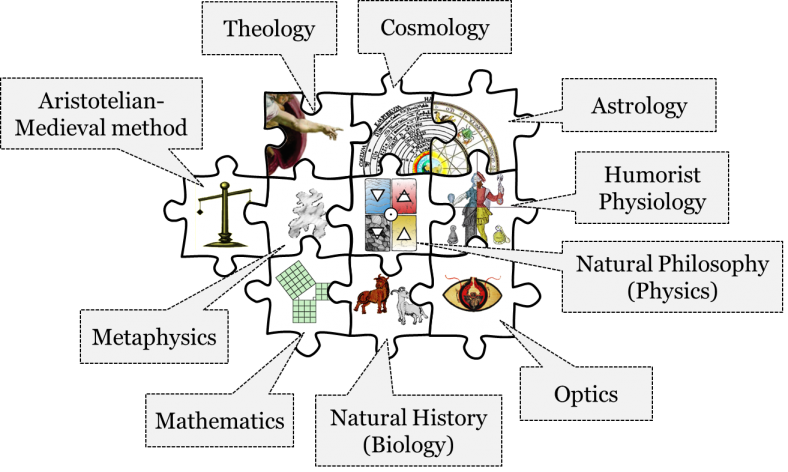
While there were many different varieties of the Aristotelian-Medieval mosaic, all of them shared a number of key elements. In one form or another, these central elements remained accepted by different epistemic communities until ca. 1700. It is these elements that we are going to focus on in this chapter.
Aristotelian Physics / Natural Philosophy
One of the key elements of this mosaic was Aristotelian physics, or natural philosophy as it was also often referred to at that time. Implicit to this physics was the idea that the universe consists of two distinct regions – terrestrial (or sublunar) and celestial. Everything within the terrestrial region was believed to be made out of the four terrestrial elements – earth, water, air, and fire. As we already know, two of these elements – earth and water – were thought to be heavy, while the other two elements – air and fire – were thought to be light. It was also believed that earth is heavier than water, while fire is lighter than air.
All of these elements were believed to have a natural position in the universe and each element was thought to have a natural tendency to get to that natural position and remain there. The natural position of the heavy elements earth and water was thought to be the centre of the universe and, thus, they were thought to have a natural tendency to descend towards the centre of the universe. As for the light elements air and fire, it was believed that their natural position is the periphery of the sublunar (terrestrial) region. Therefore, they were thought to have a natural tendency to ascend along the radius of the universe towards the periphery of the terrestrial region. The basic Aristotelian laws of natural motion can be formulated as follows:
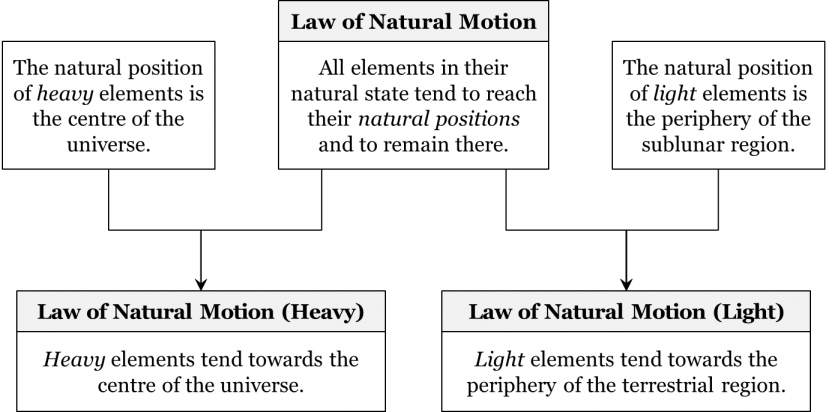
These seemingly basic laws allowed Aristotelians to explain a wide array of terrestrial phenomena. Why does fire penetrate through air while ascending? Because fire has a natural tendency to ascend toward the periphery of the sublunar region and because fire is lighter than air, through which it penetrates. Why does a stone sink in water? It is because the stone is made predominantly out of the element earth and because earth is heavier than water.
One straightforward consequence of this physics was the idea that earth, water, air, and fire should be arranged in that very same order starting from the centre of the universe all the way to the edge of the terrestrial region. As the heaviest element, earth should naturally collect at the centre of the universe, with a layer of water on top of it. After that comes the layer of air followed by a layer of fire up in the skies; a layer that we don’t usually see but know is there, since that’s where all the burning fire ascends. Thus, the idea of geocentrism is implicit in this theory: the Earth, which is a combination of the elements earth and water, must necessarily be located at the centre of the universe. Importantly, geocentrism wasn’t the result of a random choice, but was dictated by the accepted physics of the time.
Now, why would they accept the existence of precisely those four terrestrial elements? As we already know from previous chapters, Aristotelian-Medieval science was a science of common sense; a theory was thought to be acceptable if it was grasped intuitively by an expert. But what is so intuitive about the idea of four elements? If we look around us, we see that some things are solid, others are liquid, and yet others are gaseous. We also notice that there is fire which is different from the previous three. Thus, it seems intuitive to suggest that all things are made of earth (solid), water (liquid), air (gas) and fire. So, it is perhaps for this reason that many different epistemic communities in different geographic regions including Japan, India, and Egypt, arrived at a similar idea. While we no longer accept the idea of four elements, nowadays we do accept that solid, liquid, gas, and plasma are four states of matter. We can easily see why the idea of four elements appeared intuitively true.
It was also accepted in the Aristotelian-Medieval worldview that the four terrestrial elements are characterized by a pair of sensible qualities of cold/hot and wet/dry. Thus, fire is hot and dry, air is hot and wet, water is cold and wet, and earth is cold and dry.
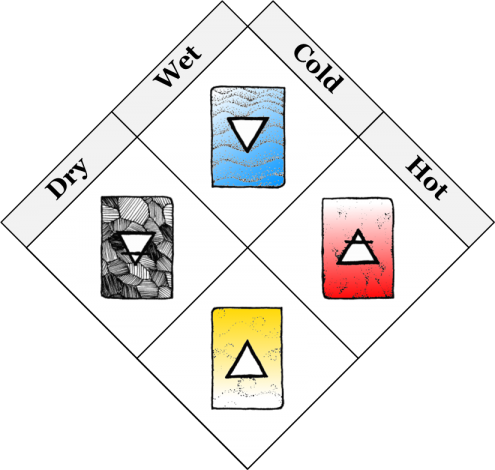
Because the elements were believed to bear a specific pair of these sensible qualities and because it was known that these qualities can transform into one another, it was also accepted that the elements themselves can transform into one another. Such a transformation would require changing at least one of the underlying sensible qualities. For instance, since water is cold and wet, if we were to turn its quality of cold into hot, we would thus transform water into vapor, i.e. air. According to Aristotelian physics, that is exactly what happens during the heating of water. The idea of transformability also explains the process of combustion of wood. Since wood falls down when dropped, we can conclude that it is made out predominantly of heavy elements – earth and water. Both of these elements have the sensible quality of cold. In combustion, this quality of cold is turned into hot, which results in the earthly parts being transformed into fire (hot and dry), and watery parts into air (hot and wet).
This idea of the transformability of the elements legitimized the study of these transformations, alchemy. Since the four elements transform into one another, it only makes sense to study how exactly they do so. While alchemy was concerned with transformations of all kinds, it was specifically interested in obtaining the so-called philosopher’s stone and the elixir of life – two elusive yet potentially possible substances. The philosopher’s stone was believed to be an alchemical substance – a stone or powder – that could help transform any base metal into gold or silver. As for the elixir of life, it was thought to be a potion that would restore the perfect balance of bodily fluids and, potentially, grant eternal life. The possibility of both the philosopher’s stone and the elixir of life was based on the idea that metals as well as bodily fluids, by way of being composed of different combinations of terrestrial elements, could transform to other metals and fluids. Needless to say, the alchemists failed to produce either of these substances. It is still very much an open question whether any alchemical theory was actually an accepted part of the Aristotelian-Medieval mosaic, or whether alchemical theories were merely pursued. What is well known is that the very possibility of alchemy was beyond question.
Humoral Physiology and Medicine
In the absence of any miraculous elixirs, medieval physicians had to rely on more down-to-earth remedies to restore the balance of bodily fluids. But what is this balance, and why was it so important to restore it? The answer has to do with the humoral physiology and medicine that was developed by, among others, Hippocrates and Galen and was an essential part of the Aristotelian-Medieval mosaic.
According to humoral theory, the human body contains four bodily fluids, the so-called humors: blood, yellow bile, black bile, and phlegm. Why were there exactly four humors? The reason is that everything in the terrestrial region, including the humors in the human body, was believed to consist of different combinations of the four elements. Thus, one crucial difference between any two humors should be those specific combinations of elements which make up these humors. Naturally, the four elements can combine differently and, therefore, different humors will have a different predominant element. In blood, the predominant element is air. The predominant element in yellow bile is fire. In black bile, the predominant element is earth. Finally, the predominant element of phlegm is water.
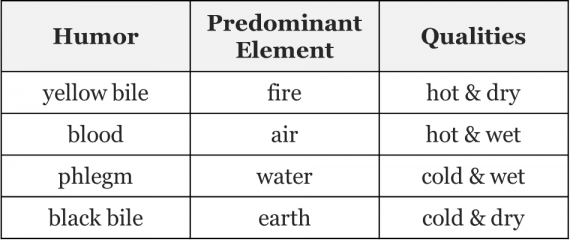
By way of having a predominant element, each of these four humors was also characterized by a pair of sensible qualities of hot/cold and dry/wet. Thus, yellow bile was believed to be hot and dry, whereas blood was believed to be hot and wet. Phlegm was characterized as cold and wet, and black bile as cold and dry.
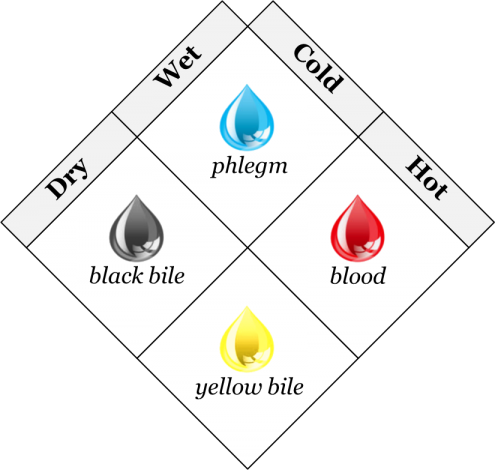
Importantly, as the constituents of the human body, these humors were thought to be responsible for health and disease. Health was understood as the state of the perfect balance between the four constituent humors; when the humors are in the correct proportion, then the body is healthy. Thus, a disease occurs when this natural balance is impaired by either an excess or a deficiency of a certain humor. This imbalance could be due to an array of different factors, such as unhealthy regimen (lack of sleep, exercising, sex, bathing, etc.), environmental factors (bad weather, corrupted air, etc.), or unhealthy diet.
But if a disease is a state of imbalance of humors, then curing amounts to restoring the body’s natural balance of humors. It was accepted that the human body has a natural healing ability, i.e. an ability to generate humors in the body and bring them to the state of natural balance. Thus, to cure a patient, a medieval physician was supposed to help the body restore the balance of humors. There was a wide range of means of curing available to the physician. For one, different food was believed to affect the balance of humors in a certain way. Depending on the nature of a disease, a physician could recommend a specific diet. For example, if a deficiency of blood was diagnosed, a physician could advise eating green vegetables. Similarly, moderate consumption of wine could be prescribed for normalizing black bile, just as a diet of fresh fruits could be advised in case of the deficiency of phlegm. In addition, many natural substances were thought to have therapeutic qualities and were often used as drugs for restoring humoral balance. Opium, for instance, was sometimes prescribed for reducing an excess of blood. It was also accepted that the human body has a natural healing ability, so a proper regimen was often thought to be the best treatment. Exercising, sleep, and bathing were believed to have a potency to increase or decrease respective humors. Moderate exercise, for instance, was believed to be conducive to building blood, while cold baths were believed to help increase phlegm. In extreme cases, if a specific humor had to be reduced immediately, a physician could opt for cleansing the body through a variety of body-purging therapies, such as laxatives, diuretics, expectorants (coughing), emetics (vomiting), enema, cautery (application of hot iron) as well as the all-time favourite – bloodletting.
In addition to natural causes of disease, it was accepted in the Aristotelian-Medieval mosaic that a disease can also be due to supernatural causes, i.e. it can be a divine punishment for a sin or a stimulus for spiritual growth. Similarly, in addition to a variety of natural therapies, curing could be achieved by supernatural means, such as God’s direct intervention. Thus, praying for the patient’s healing was considered an important addition to administering specific body-purging therapies or prescribing a specific diet and regimen.
It is important to note that the healthy natural balance of humors was believed to be different for different people. The natural balance of one person – the balance they were born with – could easily differ from the natural balance of another person. Thus, different people would have individual balances where different humors were predominant. For some people, blood would be the predominant humor of their natural balance. For others, it would yellow bile, or black bile, or phlegm. It was accepted that each individual is born with a specific balance of humors.
An individual’s specific balance of humors was believed to determine their temper, or temperament. Four basic temperaments were believed to exist, each characterized by a predominant humor. Choleric temperament was a result of the predominance of yellow bile and was characterized as irritable, bold, and confrontational. In contrast, sanguine temperament was believed to be due to the predominance of blood in the person’s balance; this temperament was described as optimistic, enthusiastic, and sociable. Phlegmatic temperament was a result of phlegm’s predominance and was portrayed as compassionate, sensitive, and passive. Finally, the predominance of black bile was believed to result in melancholic temperament which was portrayed as practical, serious, and pessimistic.

Since different people were believed to be born with different balances of humors, i.e. with different temperaments, it was essential for a physician to be able to determine the patient’s temperament in order to provide a proper diagnosis, administer efficient treatment, as well as recommend a specific diet. For example, since sanguines were believed to suffer from excess heat and moisture, they were also thought to be prone to overeating and overdrinking. Thus, they would typically be advised to stay away from fatty foods, sweets, as well as excessive drinking. In contrast, melancholics were believed to suffer from excess cold and dryness, resulting in coughs, sensitive skin, and arthritis in the joints. Therefore, melancholics would be advised to stay away from dry foods, consume enough healthy fats, and drink a sufficient amount of water. Similarly, cholerics were thought to be predisposed towards excess heat and dryness that would result in headaches, overexertion, and injuries. So, a recommended regimen for a choleric would involve limiting fatty, salty, and hot foods, as well as taking physical activity in moderation. Finally, phlegmatics were believed to suffer from excess cold and moisture that would manifest in colds, allergies, and anemia. Consequently, a phlegmatic would be advised to consume foods that are conducive to heat and dryness, i.e. to regularly eat meat rather than exclusively vegetarian food.
But why are different people born with different temperaments? What determines which specific temperament a person is born with? Surely, this cannot be random and must depend on something. So, what would determine a person’s temperament? The short answer is: their natal horoscope.
Cosmology and Astrology
To understand how exactly a person’s natal horoscope was believed to determine their temperament, we have to take a step back and appreciate Aristotelian-Medieval views on the structure of the universe – their cosmology.
As we already know, it was accepted in the Aristotelian-Medieval mosaic that the universe has two distinct regions – terrestrial and celestial. While the terrestrial region was believed to consist of the four terrestrial elements of earth, water, air, and fire, the celestial region was believed to contain only one element – aether, also known as quintessence (Latin for “fifth element”). The celestial region was believed to be filled with aether, and all stars, planets, and spheres to which they are attached were believed to be made out of aether. Whereas the terrestrial elements had a natural tendency to either ascend to the periphery of the terrestrial region, or to descend towards the centre of the universe, it was believed that the natural tendency of aether is to revolve in circles around the centre of the universe.
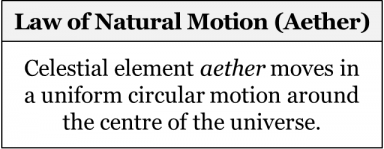
Since aether revolves around the centre of the universe, all planets and stars must also revolve around the centre of the universe, i.e. around the Earth. According to the then-accepted theory of concentric spheres developed by Eudoxus, Callippus, and Aristotle, each planet is nested in a solid crystalline orb – a spherical shell, which too is made out of aether and revolves around the Earth. The whole celestial region was believed to consist of these tightly nested concentric shells. The revolution of these spherical shells around the centre of the universe was believed to explain why all planets appear to be revolving around the Earth. There were believed to be seven planets – Moon, Mercury, Venus, Sun, Mars, Jupiter, and Saturn. In order to explain the apparent motion of planets around the Earth, the theory of concentric shells posited that each planet is carried by a number of nested spheres, each revolving slightly differently. The innermost planetary sphere would have the planet nested in it and would have its poles attached to a slightly larger sphere. This slightly larger sphere would have its poles attached to an even larger sphere and so on all the way to the innermost sphere of the next planet. The outermost sphere was the sphere of fixed stars, i.e. the sphere to which all stars were attached. Collectively, this system of nested concentric spheres would reproduce the apparent paths of the planets. This system is depicted in the following drawing:
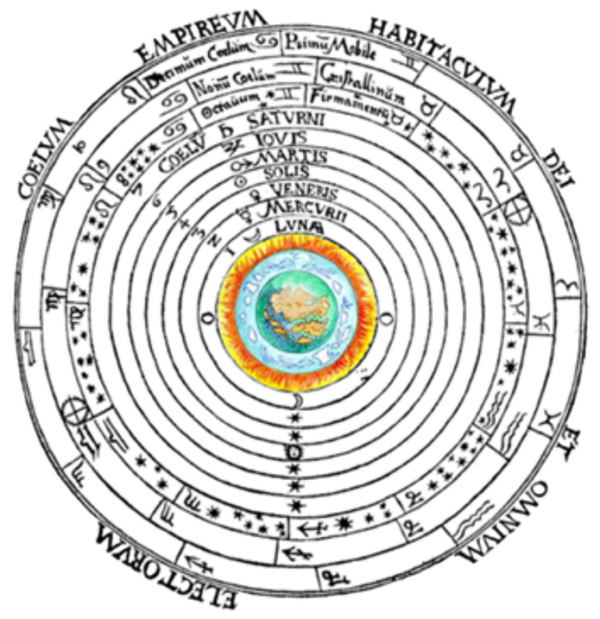
Importantly, it was believed that the celestial element aether is immutable, in the sense that it cannot transform into any other element, it cannot be generated or corrupted (except by the Creator himself, of course), i.e. it doesn’t come to be or cease to be. The only change in the celestial region had to do with the revolution of the celestial spheres; no new star, planet, or sphere was believed to be possible. This is in sharp contrast with the terrestrial region, where the four elements were believed to be mutable and where generation and corruption were the order of the day.
Now, what would happen if there were no external influences on the terrestrial region? What kind of an arrangement of elements could we reasonably expect if the laws of natural motion for heavy and light elements were not affected by anything else? If there were no external influences on the terrestrial region, then according to the laws of natural motion, the terrestrial elements would be arranged in ideal concentric spherical shells with the element earth being in the centre, followed by a layer of water, a layer of air, and a layer of fire. In such a hypothetical scenario, there would be no place for continents or islands, for all earth would have to be uniformly covered by water. Yet, we observe that not all earth is covered by water. In fact, we see that in the terrestrial region, the four elements are not arranged in perfect layers, but are mixed and combined to form all sorts of things. But how is this possible? It seemed reasonable to suspect that the terrestrial region was somehow influenced by something external to it, i.e. by the celestial region. In brief:

The conclusion that the celestial region affects the terrestrial region was in tune with several well-known phenomena. For one, it was known that the Sun exerts considerable influence on the Earth by being the main source of heat and light as well as the cause of the seasons. Similarly, the Moon – as the heavenly body closest to the Earth – was thought to cause a wide range of terrestrial phenomena. The Moon was thought to increase or decrease the flow of rivers, to cause the ebb and flow of the tides, and even to influence some biological processes in plants and animals. All these phenomena clearly suggested that terrestrial processes are somehow affected by processes in the heavens.
To explain how exactly the motion of the celestial spheres affects the terrestrial region, it was assumed that the motion of the outermost sphere of stars is due to God himself; the sphere of stars revolves eternally around the centre of the universe due to its love for God and as an attempt to mimic God’s eternity. The motion of the sphere of stars brings into motion the inner spheres; the motion is thus transferred to each subsequent sphere which eventually causes all sorts of change in the terrestrial region. While there was considerable disagreement as to what sort of celestial arrangements cause this or that type of event in the terrestrial region, the very existence of celestial influences was beyond doubt. There were believed to be numerous ways in which the motion of celestial bodies caused changes in the terrestrial regions (e.g. the Moon causing the tides, the Sun bringing heat and light). Therefore, it was reasonable to study these influences and find out exactly how changes in the celestial region bring about different terrestrial events. Enter the science of astrology.
Astrology
The presence of astrology in the Aristotelian-Medieval mosaic could initially strike one as surprising; after all, the very notion of studying horoscopes at a university sounds absurd to a 21st-century student. Yet, it should be clear by now that there was nothing strange in astrology’s inclusion into the curricula of medieval universities: the existence of celestial influences upon terrestrial phenomena was well known and, thus, there was nothing strange in devoting time and effort to studying these influences.
Note that in the context of the Aristotelian-Medieval worldview, the terms “astrology” and “astronomy” were sometimes used interchangeably: e.g. a treatise labelled as “astrological” could easily deal with astronomical subjects, and vice versa. However, to avoid confusion, we will differentiate the study of the motion of the planets (i.e. astronomy) from the study of the celestial influences on terrestrial affairs (i.e. astrology).
When an observer on the Earth studies the positions of the celestial bodies, it becomes clear that all of these bodies make a complete revolution around the Earth within the course of a day. Further observations reveal that while the relative positions of most of these bodies – the stars – remain the same, there are several curious celestial bodies – planets – which change their position relative to other celestial bodies. If we take the stars as our background, then we can notice that the positions of the planets gradually change relative to that starry background, i.e. the planets wander about the heavens. Carrying our observations further, we soon notice that the Sun completes precisely one full revolution per year and traces the same path across the heavens year after year. This apparent path of the Sun through the course of a year is called the ecliptic.
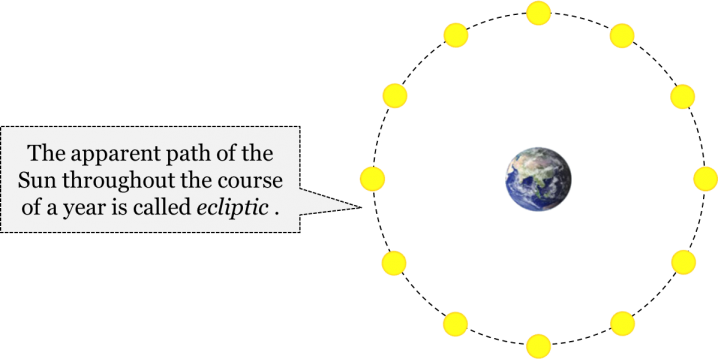
The ecliptic is in the centre of a belt that we call the zodiac. Interestingly enough, the apparent paths of all the planets are positioned within this belt of the zodiac. In other words, the circles that the planets trace in the heavens are not random but are all roughly on the same plane. Thus, they appear to be passing through the same belt surrounding the ecliptic – the zodiac.
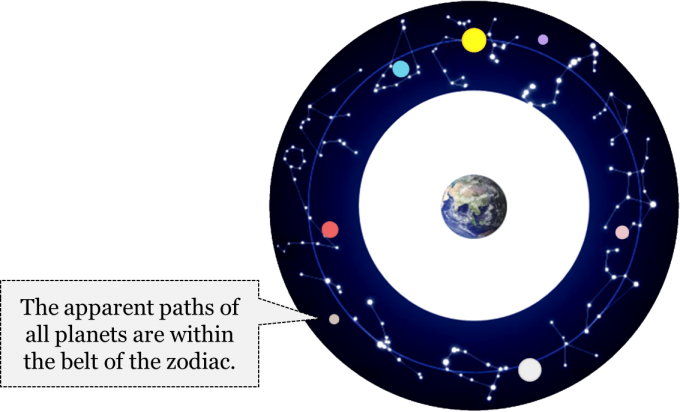
Since the times of ancient Babylon, it has been customary to divide the ecliptic into 360 degrees – just as with any other circle. The main reason for this is that there are 365 days in a year, but 365 is not easily divisible by whole numbers and, thus, 360 – the closest number that can easily be divided by a great many whole numbers to yield a whole number result – was chosen instead. It also maps nicely onto 30-day synodic lunar cycles – the cycles between each meeting of the Moon and the Sun. There are twelve such cycles within each 360-day period, i.e. twelve months. This also explains why the belt of the zodiac was divided into twelve 30-degree divisions; each division contains one constellation, i.e. one astrological sign: Aries, Taurus, Gemini, Cancer, Leo, Virgo, Libra, Scorpio, Sagittarius, Capricorn, Aquarius, and Pisces.
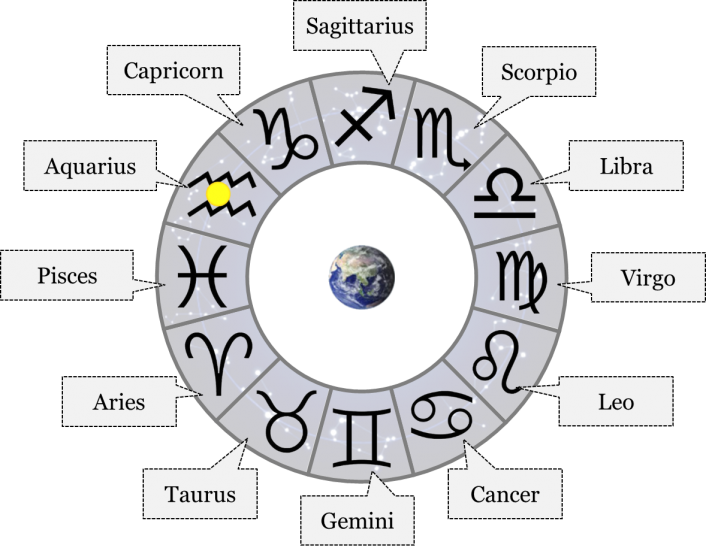
Throughout the course of a year, the Sun passes through each of these twelve signs spending about 30 days in each of them. It is not surprising that an astrologer would adopt this twelve-month or twelve-sign division while searching for correlations between celestial and terrestrial phenomena. It was reasonable to suspect that each of these twelve signs has its own distinctive features and, therefore, its own specific influence upon terrestrial events. The only remaining task was to understand how these different signs could influence different types of events in the terrestrial region.
While astrology had many fathers, it was Claudius Ptolemy (c. 100–170 CE) who compiled astrological knowledge into a comprehensive system and provided rational explanations for many of its tenets. His astrological treatise, Tetrabiblos, was considered the utmost authority on astrological matters throughout the Aristotelian-Medieval period. Among the key tenets of astrology was the idea that each individual is born under one of the twelve signs. The individual’s sign was believed to be determined by the position of the Sun at the time of their birth. For instance, an individual was said to be born under the sign of Aquarius if the Sun was in the constellation of Aquarius at the time of the person’s birth. Each of the twelve signs was believed to have a specific effect on both the person’s character and physique. But how could the planets exert this influence?
Since everything in the terrestrial region was believed to be made out of the four elements, it was reasonable to assume that celestial bodies would influence the Earth by means of increasing or decreasing the relative proportions of the four elements in people’s bodies as well as in their environment. Each planet was believed to exert specific effects on the sublunary region: the Sun heats and dries, the Moon moistens, Saturn mainly cools, Jupiter somewhat heats and moistens, etc. It was also believed that the powers of the planets could be strengthened or weakened depending on their relative positions. Since each of the seven planets could find itself in each of the twelve signs, it was also believed that these signs can influence exactly how each planet affects terrestrial phenomena. Why is that? This is because each sign was expected to have a different effect on different elements; as a result, each sign was believed to be associated with one of the four elements. Aries, Leo, and Sagittarius were said to be the fire signs. Gemini, Libra, and Aquarius were the air signs. Cancer, Scorpio, and Pisces were the water signs. And finally, Taurus, Virgo, and Capricorn were the earth signs. Different outcomes were expected depending on the specific positions of different planets in each of the twelve signs.
Among many other things, the positions of the planets at the moment of the individual’s birth were believed to shape the person’s temperament. While all the planets were believed to exert a certain influence on a person’s balance of humors, it was the position of the Sun at the moment of the person’s birth that was believed to play the central role in determining the person’s temperament. The person’s temperament essentially depended on the sign in which the Sun was found at their birth. Since each sign has an associated element, and thus an associated humor, one of the four temperaments was believed to obtain depending on the position of the Sun:

For instance, a person born under the sign of Capricorn would have earth as her predominant element. As a result, black bile would be her predominant humor and she would therefore have a melancholic temperament. Similarly, a person born under the sign of Cancer would have water as the predominant element and, thus, phlegm as the predominant humor and would therefore be a phlegmatic.
While the location of the Sun was believed to determine the temperament of the person, the locations of other planets were thought to chisel the finer features of the person’s character. For example, if at the moment of the person’s birth the Moon was in the sign of Gemini, the person would be restless and be predisposed to traveling and learning new things. If, however, the Moon was positioned in the sign of Taurus, the person would be predisposed to a steady, patterned way of life. Other planets were also believed to have considerable influence on different aspects of the person’s character. Studying these different effects was one of the main tasks of the science of astrology.
It should be clear by now why medieval physicians were supposed to know their astrology. Since a person’s temperament, health, and disease were seen as being constantly affected by celestial influences both directly and through the environment, then it would be unreasonable to assume that medicine could be practiced without astrology. To begin with, it was important to know the patient’s temperament to understand the severity of the illness. Similarly, in order to prescribe effective treatment, the medieval physician had to take into consideration the respective positions of planets. The planetary configurations would determine the dosage of drugs as well as the timing of their administration. It was also believed that surgical therapies, such a blood-letting or cautery, had to be conducted only at favourable times dictated by astrology. As a result, the knowledge of astrology, and therefore also of astronomy, was indispensable for a practicing medieval physician.
Aristotelian-Medieval Method
We already know a thing or two about the Aristotelian-Medieval criteria of theory acceptance from chapters 3 and 4. In particular, we know that the requirement of intuition schooled by experience was an essential part of the method employed for most of the history of knowledge in the West until ca. 1700. Yet, there was much more to the requirements of the medieval scholars than mere intuition schooled by experience. It is important to recall that any epistemic community can employ at least three different types of criteria. Employed demarcationcriteria decide whether a theory is considered scientific or non-scientific. Acceptance criteria are employed to determine whether a theory is accepted into the mosaic. Finally, compatibility criteria are employed to decide whether a given pair of theories can be simultaneously accepted in the mosaic.
While further research may reveal other types of criteria, it is safe to say that, at the very minimum, any epistemic community employs these three types of criteria. The Aristotelian-Medieval community is no exception. Recall that the Aristotelian-Medieval criteria of demarcation between science and non-science that we discussed in chapter 6 were an integral part of their implicit expectations. It is also clear that they had to have certain expectations concerning compatibility or incompatibility of different theories. As for their acceptance criteria, it is true that the requirement of intuitive truth was an essential part of it. However, there were also other important requirements, which determined what was and wasn’t allowed into the medieval mosaic. It is these additional requirements of theory acceptance that we will focus on in this section.
Let’s start with our explication of the most general acceptance criteria of the Aristotelian-Medieval method:
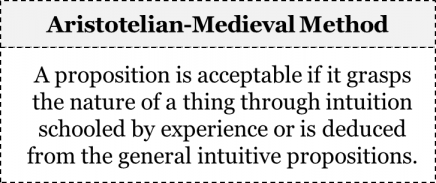
As we already know from chapter 4, this method was based on two assumptions about the world. The first assumption was the idea that every natural thing has its nature, an indispensable quality that makes the thing what it is. For example, the indispensable quality of an acorn, its nature, is the capacity to grow into an oak tree, the nature of a lion cub is to become a full-grown lion, and the indispensable quality of humans is their capacity of reason. The second assumption was the idea that the nature of a thing can be grasped intuitively by an experienced person: the more time one spends observing the thing under study, the better one is positioned to grasp the nature of that thing. It is important not to confuse these assumptions with the requirements of the method; the requirements are those expectations that a theory should satisfy in order to become accepted, while the assumptions are those beliefs about the world from which these requirements deductively follow (by the third law). In the case of the Aristotelian-Medieval method, the requirements are the intuitive truth of a theory or its deducibility from what is intuitively true.
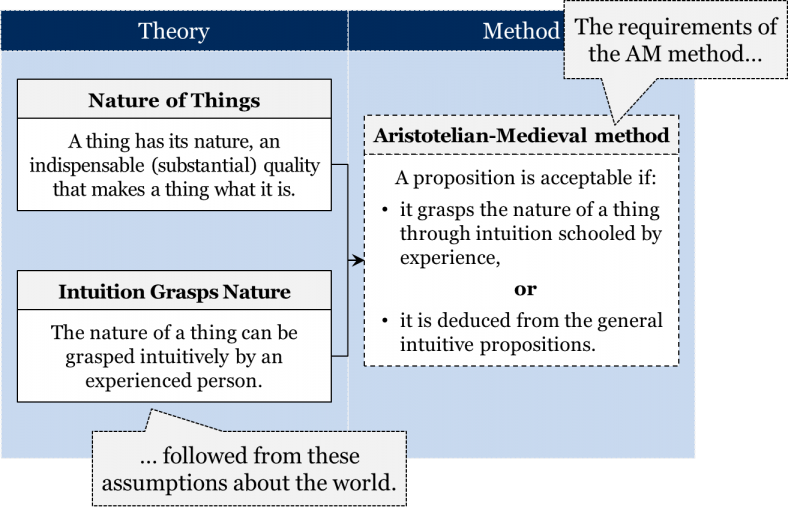
To illustrate the Aristotelian-Medieval requirements, consider an example from geometry:
The sum of the interior angles of a triangle is equal to that of two right angles.
This proposition is true, since it reveals the very nature of a triangle – that is what it is to be a triangle. Taking this proposition as our axiom, we can now deduce something more specific:
The sum of the interior angles of an equilateral triangle is equal to that of two right angles.
This theorem is true since any equilateral triangle is also a triangle.
The idea that’s implicit here is that it is easier to notice those properties that are common to all objects of a class. Therefore, any inquiry was supposed to start from an identification of the most general first principles, axioms, from which the rest of the system – the theorems – could be deduced. For instance, since the idea of four terrestrial elements – two heavy and two light – was considered to be intuitively true, it was accepted as one of the axioms of Aristotelian-Medieval natural philosophy. From this axiom many theorems were deduced, including the idea that the Earth, a combination of the elements earth and water, should necessarily be in the centre of the universe. All of the sciences of the Aristotelian-Medieval mosaic would proceed in a similar fashion: they would attempt to grasp the most general, indispensable features of things under study and would then proceed to uncovering more specific features of things.
But what does it mean for something to be intuitively true? Yes, the axioms of our knowledge should be grasped as intuitively true, but surely not every intuition is an acceptable intuition. According to Aristotle and his followers, intuitions only count if they are schooled by years of experience in the respective field. Thus, if one wishes to know what the nature of bees is, one doesn’t ask a random person, but only an expert – an apiarist, who has spent a lifetime observing bees in proximity. Similarly, if one’s goal is to know the nature of human beings, one should, according to Aristotelians, refer to the intuitions of a philosopher who has spent years observing humans and reflecting on their traits. The key point here is that one must have a lifetime of experience with a thing under study to be properly positioned to grasp the nature of that thing; therefore, only an expert’s intuitions count. Aristotelian-Medieval science was a science of common sense, but the common sense of an expert, not a layman.
In addition to the requirement of intuitive truth, the Aristotelian-Medieval method of theory acceptance included a few other ingredients. One important ingredient of that method was the requirement that we should only rely on observations when evaluating a theory, i.e. that the results of experiments can be effectively ignored. Now, how could anyone dismiss the results of experiments and rely solely on the results of observations?
The answer has to do with the Aristotelian-Medieval distinction between natural and artificial. What is a natural thing? A thing is said to be natural if it is not produced artificially and, thus, has an inner source of change. A rock, for instance, is a heavy object and, by virtue of its heaviness, has an inner tendency to descend towards the centre of the universe. The same applies to all natural things. Animals reproduce because that’s their inner tendency dictated by their very nature. Humans engage in studying the world around them because that’s their inner tendency dictated by their nature – the capacity of reason. In all of these cases, the source of change is the very nature of the thing.
Compare this with something artificial, say, a compass. A compass is created by a craftsman to aid with navigation by showing the direction North. As such, it exists for the sake of something external to itself, i.e. for the sake of navigation. The same goes for a clock that is built to serve a purpose that is external to the clock itself – the purpose of timekeeping. It doesn’t have an inner source of change, as it exists not for its own sake but as an aid for keeping time. According to the Aristotelian-Medieval way of thinking, this applies to all artificial things which, by definition, are the ones crafted by humans to perform some useful task and, thus, have an external source of change.

It was accepted in the Aristotelian-Medieval mosaic that there is a strict distinction between natural and artificial – between things with their inner source of change and things with an external source of change. Albeit foreign to us in the 21st century, this strict distinction between natural and artificial was accepted in the Aristotelian-Medieval mosaic and played an instrumental role in shaping their criteria of theory evaluation. Specifically, it follows from this distinction that in artificial conditions things cannot behave naturally; natural behaviour presupposes natural conditions. But any experiment, by definition, assumes a certain artificial setup; it is this artificial setup that differentiates experiments from observations. This explains why in the Aristotelian-Medieval mosaic experiments were not considered a trustworthy source of knowledge. It was believed that if we were to uncover the nature of a thing under study, subjecting it to experiments would be of no use. In other words, one had to study things in their natural unaltered condition, for experiments are artificial and do not reveal the nature of things. For example, if we are to unearth the nature of honeybees, we should not lock them inside a house where they have no access to pollen and nectar. That would put honeybees in an environment that is not natural to them and would therefore prevent us from seeing how they behave in their natural environment. As a result, we wouldn’t be able to grasp their nature. The only right way of studying the bees is by observing them in their natural condition, when they behave in accord with their nature. Generally speaking, it was accepted at the time that any sort of experimentation is deficient because of its inevitable introduction of an artificial setup:
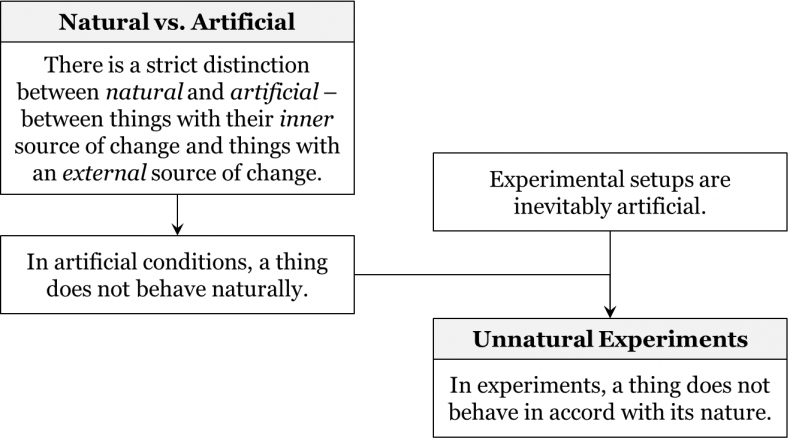
The third law of scientific change suggests that this belief had to shape their employed method and, sure enough, it did. The Aristotelian-Medieval community would not accept a theory about the nature of a thing if the latter relied in any way on experiments:

This should make it evident that the medieval dismissal of experiments as a reliable source of knowledge wasn’t the result of a random whim but was based on the then-accepted strict distinction between natural and artificial. This restriction persisted until the end of the 17th century. It was removed with the acceptance of the Cartesian and Newtonian mosaics, which we will discuss in chapters 8 and 9.
Now, let’s consider another important ingredient of the Aristotelian-Medieval method – their requirement concerning the limited applicability of mathematics. To appreciate this requirement, we should start from the then-accepted distinction between quantitative and qualitative changes. It was accepted that while some changes concern the number, shape, or size of things, other changes concern their qualities, and these changes cannot be expressed quantitatively. When a man grows in height or gains weight, these are instances of quantitative change, as they can be expressed in numbers. However, when a person learns to read or write, or masters a second or third language, we are no longer dealing with instances of quantitative change; these changes are qualitative since they cannot be expressed through numbers. The acquisition of the ability to speak another language is not about the number of memorized words but about the acquisition of a new quality. Similarly, when a caterpillar gradually transforms into a chrysalis and then into a butterfly, it acquires entirely new qualities, such as the capacity to fly.

Because qualitative changes were thought to be unquantifiable, it was accepted in the Aristotelian-Medieval mosaic that the distinction between qualitative and quantitative changes is strict. This is not something we would agree with nowadays in the 21st century. For example, we might argue that the learning of a new language consists, fundamentally, of quantitative changes in the strengths of vast numbers of synaptic connections between nerve cells in the learner’s brain. But, at the time, it was believed that qualitative changes are really not about changes in shape, size, or number, but about the acquisition or loss of qualities.
Now, what does this tell us about the applicability of mathematics? By definition, mathematics is only applicable to quantifiable phenomena, i.e. phenomena which are explicable in terms of number, shape, or size. Indeed, in order to apply mathematics to a certain type of change, we must first manage to quantify that change, i.e. to express that change through numbers. But if qualitative changes are not expressible numerically, then no mathematics can possibly be applied to them. That’s why it was accepted in the Aristotelian-Medieval mosaic that mathematics is inapplicable to instances of qualitative change:
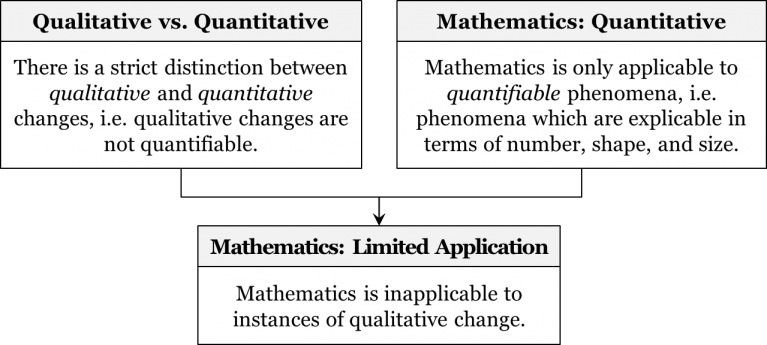
By the third law, it followed from this belief that no mathematical description of a qualitative change can be accepted. This requirement of the Aristotelian-Medieval method can be formulated as follows:

This restriction affected all those fields of inquiry that dealt with qualitative changes, including biology (natural history) and physics (natural philosophy). Of course, there was no reason why mathematics could not be applied to those biological phenomena that were quantifiable; nobody would object to counting, say, the number of limbs or teeth of a certain creature. In the same fashion, there was no objection to applying mathematics to the study of locomotion, since any change of position is readily expressed geometrically. However, when it came to describing the instances of qualitative change, the application of mathematics was believed to be impossible. Consider a lion cub that gradually learns and finally acquires the ability to hunt, or consider a human being that learns a certain craft – such changes were believed not to be amenable to mathematical treatment. Once again, we see how a simple line of reasoning that stemmed from a strict distinction between quantitative and qualitative had serious consequences for the practice of science.
Summary
Summarizing a worldview is not an easy task. Perhaps the best way of doing it is by comparing one worldview to another; that’s what we will be doing in chapters 8, 9, and 10, when we study the Cartesian, Newtonian, and Contemporary worldviews respectively. In the next few chapters, we will be revisiting the Aristotelian-Medieval worldview on several occasions and will show how it was different from the other worldviews.
For now, let’s appreciate how interconnected different elements of the Aristotelian-Medieval mosaic were. Having as its root the requirement to accept only what is intuitively true, what is commonsensical, Aristotelian-Medieval science managed to achieve a high degree of mutual agreement between its different elements. Such a degree of mutual agreement has not since been replicated.

